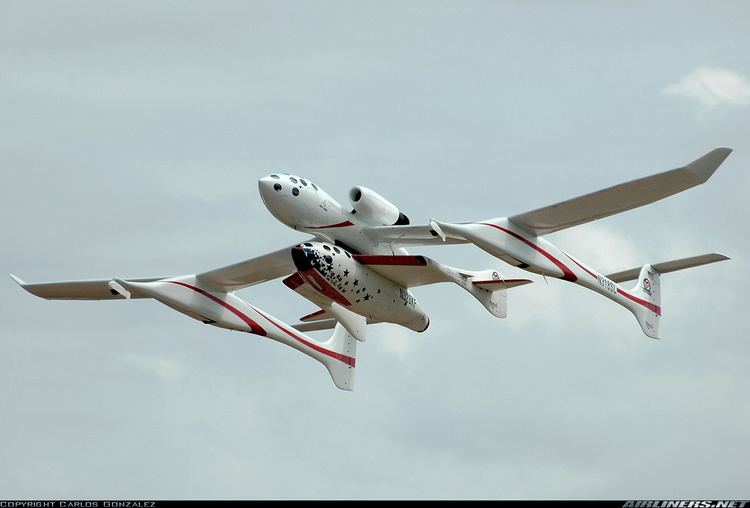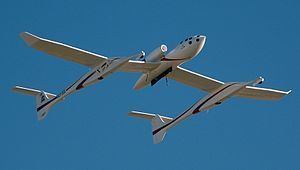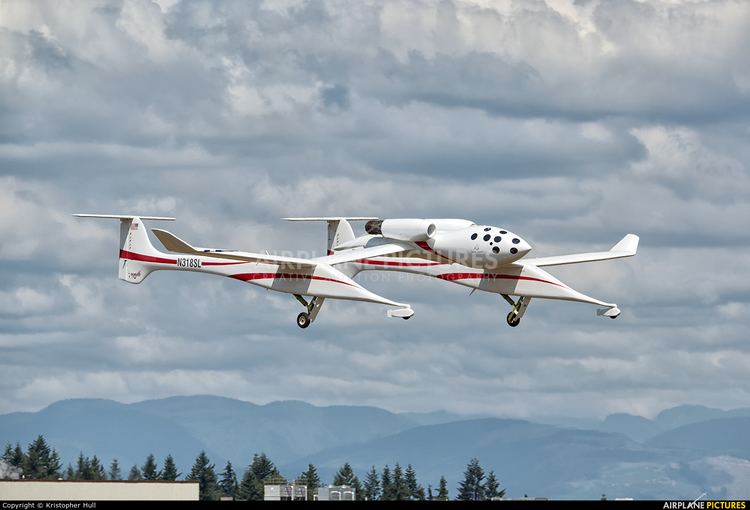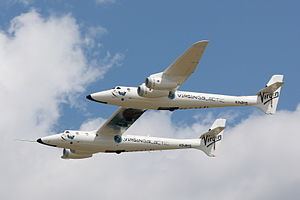First flight August 1, 2002 | ||
 | ||
Scaled composites white knight two
The Scaled Composites Model 318 White Knight (now also called White Knight One) is a jet-powered carrier aircraft used to launch the Scaled Composites SpaceShipOne experimental spacecraft. It was developed by Scaled Composites as part of its Tier One program. The aircraft was subsequently offered by Scaled on a contract basis as a research testbed, and was used for drop tests of the Boeing X-37 spaceplane from June 2005 until April 2006. It is also the predecessor to White Knight Two.
Contents
- Scaled composites white knight two
- Design and development
- SpaceShipOne program
- X 37 test program
- Adaptive Compliant Wing test program
- Retirement to museum
- Specifications
- Other features and capabilities
- References
Design and development
The Scaled Composites model number for White Knight is 318. White Knight is registered with the Federal Aviation Administration as N318SL.
The White Knight carrier airplane was designed around the twin afterburning J-85 engines, which were selected for their availability and low cost. The aircraft was a completely new independent design. White Knight and SpaceShipOne shared the same forward fuselage outer mold line (OML) to reduce development costs and with the original intent to allow for White Knight to act as a flying simulator for training SpaceShipOne pilots. White Knight first flew on August 1, 2002. The flight was aborted shortly after takeoff due to a problem with the outboard wing spoilers. These trailing edge spoilers were designed to greatly increase the glide slope so that the White Knight vehicle could act as a flying simulator for training of SpaceShipOne pilots. During the first flight, the mechanical over-center torque was insufficient to maintain the spoilers in the closed position. The spoilers deployed into the free stream and began a limit cycle forcing the pilot (Mike Melvill) to abort. The spoilers were subsequently disabled completely and the desire for a steep glide slope matching SpaceShipOne was abandoned.

White Knight next flew on August 5, 2002, and this time performed well. Development proceeded over the next few months. With White Knight developed and evaluated, on April 18, 2003, White Knight and SpaceShipOne were presented to the media.

Subsequently, White Knight flew as part of the Tier One program that won the Ansari X Prize on October 4, 2004.

Afterwards, White Knight was used to carry and launch DARPA's experimental X-37 spaceplane for its approach and landing tests in 2005 and 2006.
It was followed up by the White Knight Two, which has a similar but larger design.
SpaceShipOne program
Flights of White Knight are numbered, starting with flight 1 on August 1, 2002. Flights where SpaceShipOne was carried also get one or two appended letters. An appended "C" indicates that the flight was a captive carry, and "L" indicates that SpaceShipOne was launched. If the flight actually flown differs in category from the intended flight, then two letters are appended, the first giving the intended mission and the second the mission actually performed.
X-37 test program
White Knight was contracted to perform both captive carry and drop test flights of the DARPA/Boeing X-37. First captive carry flight was on June 21, 2005, and first drop was on April 7, 2006 (the X-37 was subsequently damaged on landing at Edwards AFB). Initially, the flights originated from Mojave, but following the landing incident, the program was moved to Air Force Plant 42 in Palmdale, California, and at least five subsequent flights were made there.
Adaptive Compliant Wing test program
In late 2006, White Knight flew a seven-flight test program of the Adaptive Compliant Wing developed by FlexSys Inc with funding by the Air Force Research Laboratory. A laminar flow test article was mounted vertically under White Knight's centerline pylon for the 20-flight-hour research program that tested the flexible wing's aerodynamic characteristics.
Retirement to museum
In July 2014 White Knight made its final planned flight, arriving at Paine Field in Everett, Washington, to become part of the Flying Heritage Collection.
Specifications
Data from Scaled Composites
General characteristics
Performance
